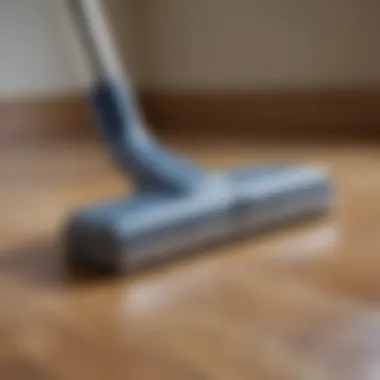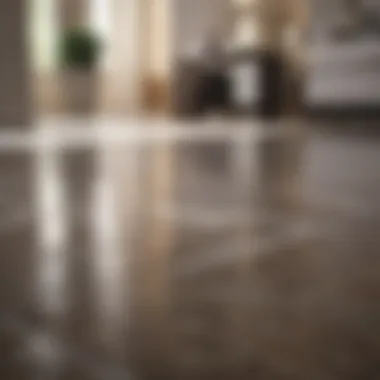Effective Methods for Cleaning Greasy Laminate Floors


Intro
Greasy laminate floors often present a challenge for homeowners. Understanding how grease accumulates can aid in maintaining aesthetics and safety. Proper cleaning methods are essential in addressing these issues, especially in high-traffic areas. This guide explores effective techniques for dealing with grease on laminate surfaces, emphasizing tools and products that ensure longevity and appeal.
Featured Homes
Architectural Styles
Laminate flooring is popular in various architectural styles. Whether in modern apartments or traditional homes, it serves both functionality and elegance. Attention to detail in cleaning keeps the character of the structure intact while enhancing the overall look.
Unique Design Elements
The versatility of laminate allows it to mimic more expensive materials like hardwood or stone. This affordability makes it a preferred choice in design. Regular upkeep, especially in areas susceptible to grease, helps maintain these unique design elements. Quality cleaning can bring out the beauty in any laminate floor design.
Understanding Grease Accumulation
Grease can accumulate from cooking, pet activities, or even accidental spills. If not addressed quickly, it can lead to dullness and make the floor slippery, which raises safety concerns.
Impact of Greasy Floors
A greasy floor can negatively impact the home environment. It can lead to:
- Reduced traction, increasing fall risks.
- An unsightly appearance that detracts from the home’s decor.
- Potential damage over time if not properly cleaned.
Effective Cleaning Techniques
Tools and Products
Choosing the right tools is crucial for effective cleaning. Here are some necessary items:
- A soft-bristle broom or microfiber mop
- A bucket for mixing cleaning solutions
- Non-abrasive cleaners specifically designed for laminate
- Towels for drying and buffing
Step-by-Step Methods
- Sweep or Vacuum the Floor: This initial step removes loose dirt and debris.
- Prepare a Cleaning Solution: Using a mixture of warm water and a few drops of mild dish soap is effective.
- Clean the Floor: Using a mop dampened in the cleaning solution, go section by section. Avoid soaking the floor, as excess water can damage laminate.
- Rinse with Clean Water: After cleaning, mop the floor again with plain water to remove any residue.
- Dry the Floor: Use a clean, dry towel to wipe the surface and prevent slips.
Maintenance Tips
To prevent future grease buildup, consider these practices:
- Place mats in cooking areas to catch spills.
- Clean up spills immediately to reduce staining.
- Regularly scheduled cleanings keep grease from settling.
Culmination
Foreword to Greasy Laminate Floors
Understanding how to maintain laminate floors is crucial. Greasy laminate floors are not just an aesthetic concern; they can also impact safety. The accumulation of grease makes surfaces slippery, leading to potential accidents. It is important to know how to effectively clean these spaces to preserve their appearance and functionality.


Understanding Laminate Flooring
Laminate flooring has gained popularity for various reasons. It mimics the appearance of wood or stone while offering a cost-effective and maintenance-friendly solution. Typically, laminate consists of a high-density fiberboard core, a layer of photographic image, and a clear protective layer. This construction allows it to withstand scratches and dents, making it ideal for homes with pets or high foot traffic. However, despite its robustness, laminate can still suffer from grease buildup. This can arise from cooking, spills, or everyday wear and tear.
Common Sources of Grease Buildup
Grease can accumulate on laminate flooring from several common activities. Cooking oil can splatter during meal preparations, leaving behind residues that make the floor sticky and unattractive. Additionally, food particles, such as crumbs and sauces, can fall or spill, contributing to a greasy layer. Finally, general dirt, dust, and grime accumulate over time, often mixed with moisture and oils from shoes. Being aware of these sources is the first step to maintaining the cleanliness of your laminate floors.
Identifying the Type of Grease
Understanding the type of grease on your laminate floors is crucial for effective cleaning. Different sources of grease require tailored approaches to removal. Recognizing the specific type you are dealing with can save time, effort, and potentially prevent damage to your flooring. It allows for the use of the most suitable cleaning products and methods appropriate for the situation.
Cooking Oil Residues
Cooking oil residues are often found in kitchens. They are typically produced during everyday cooking activities. When oil splashes onto laminate floors, it can leave a sticky and greasy residue that attracts dust and dirt. To clean this type of grease effectively, a degreaser or a solution specifically designed for kitchen use is beneficial. For instance, using vinegar mixed with warm water can help break down the oil effectively. Applying it with a microfiber mop ensures the surface is not oversaturated, thereby avoiding any potential damage to the laminate.
Food Particles and Spills
Food particles can be another significant source of grease on laminate floors. These may come from crumbs, splatters, or spills. Left unattended, these residues can lead to unpleasant odors and contribute to a greasy floor surface. Cleaning methods for this type involve immediate attention to spills to prevent them from setting. For everyday cleanup, a dry mop can be briefly used to gather loose particles before following up with a damp mop using warm soapy water. Regularly cleaning food spills not only improves the floor's appearance but also contributes to a more hygienic environment.
General Dirt and Dust Accumulation
Over time, general dirt and dust can accumulate on your floors, mixing with any existing grease. This buildup can lead to dull and lackluster floors. To combat this, a regular cleaning regimen should be established. Start with sweeping or vacuuming to remove loose dirt, followed by mopping with a suitable cleaner. This step is vital to maintaining the aesthetic appeal of your laminate flooring. An effective way is to use a combination of warm water and a few drops of a pH-balanced cleaner. This method not only cleans but also preserves the integrity of the flooring material.
Efficiency in cleaning is greatly enhanced when the type of grease is correctly identified and treated with the right products. Keeping these types in mind simplifies maintenance and ensures your laminate flooring remains in optimal condition for years to come.
Necessary Cleaning Tools and Supplies
Cleaning greasy laminate floors requires the right tools and supplies to achieve effective results. Using suitable equipment can make a significant difference in both the cleaning process and outcome. Proper tools not only facilitate easier cleaning but also help in preventing damage to the laminate surface. Without the right supplies, one may risk ineffective cleaning or even damaging the flooring, which is a common concern for anyone maintaining laminate surfaces.
Choosing the Right Mop
Selecting the correct mop is critical for cleaning laminate floors effectively. There are various types of mops available, each designed for specific cleaning tasks.
- Microfiber Mops: These are popular because they are designed to trap dirt and grease effectively. Microfiber is gentle on laminate surfaces, minimizing scratches.
- Spin Mops: They offer ease of use and can be very efficient in collecting dirt.
- Flat Mops: These can reach under furniture easily and allow for a better angle when cleaning.
It is important to choose a mop with a removable and washable pad to maintain hygiene and effectiveness. An adjustable handle can also enhance user comfort.
Effective Cleaners for Laminate Floors
Laminate flooring can be delicate, so using the right cleaners is essential. There are commercial cleaning solutions and DIY options available, each with their own strengths.
Commercial Cleaning Solutions
Commercial cleaning solutions are specifically formulated for laminate floors. They contain ingredients that combat grease and restore shine without disrupting the protective layer of the laminate. A key characteristic of these solutions is their convenience.
- Advantages: They often come with clear instructions for use and sometimes have added benefits, like fragrance. They are readily available and typically yield quick results.
- Disadvantages: Some commercial cleaners can be expensive, and others may contain harsh chemicals that could damage the laminate over time.


DIY Cleaning Solutions
DIY cleaning solutions allow for customization based on personal preferences and available ingredients. These solutions often use common household items such as vinegar and water or dish soap diluted in water. A key characteristic of DIY cleaners is their cost-effectiveness.
- Advantages: They are inexpensive and can be made in larger quantities. Many people prefer them because they can avoid harsh chemicals found in some commercial products.
- Disadvantages: Effectiveness can vary, and it might take experimentation to achieve the desired results. Additionally, some DIY cleaners could still harm the floor if not mixed properly or if used too frequently.
In summary, having the right mops and cleaners for laminate floors will greatly improve the cleaning process. Whether opting for commercial solutions or opting for DIY methods, understanding their features helps ensure that your laminate flooring retains its appearance and durability.
Step-by-Step Cleaning Process
The step-by-step cleaning process is the backbone of maintaining greasy laminate floors. A systematic approach ensures that each aspect of the cleaning is addressed thoroughly. This not only restores the floor's appearance but also enhances the overall hygiene of the space. The structure provides clarity and helps prevent damage that could arise from improper cleaning practices. Moreover, understanding each step equips homeowners with the knowledge to handle different levels of grease accumulation effectively.
Initial Preparation
Removing Loose Dirt and Debris
Removing loose dirt and debris is vital before any cleaning solution is applied. This initial action prepares the surface for deeper cleaning. A clean surface prevents particles from scratching the laminate during the cleaning process. Tools such as a broom or vacuum cleaner are effective choices here.
The key characteristic of this step is its simplicity and efficiency. It’s a beneficial choice because it significantly reduces the amount of grime that will mix with the cleaning solution, making the process more effective.
A unique feature of this step is the minimal time it requires. In just a few minutes, one can greatly improve the cleanliness of the floor. However, neglecting this step can lead to ineffective cleaning, as dirt may still settle on the surface while mopping.
Gathering Cleaning Supplies
Gathering cleaning supplies is another essential aspect of preparation. It ensures that all necessary tools are on hand before starting. This can include mops, cloths, and the chosen cleaning solution. Having everything ready prevents interruptions during the cleaning process, allowing for a more focused cleaning session.
The key characteristic of this step is organization. It sets the tone for an efficient cleaning experience. This choice is particularly beneficial as it allows the person cleaning to achieve consistent results without searching for items mid-task.
One unique feature of gathering supplies is the importance of selecting appropriate products. Using the wrong cleaners can damage laminate flooring, which poses a disadvantage for those who might overlook this detail. This makes careful selection crucial to the overall outcome.
Applying the Cleaner
Using a Mop for Even Distribution
Using a mop for even distribution of the cleaner is critical for effective cleaning. A mop allows for a controlled application of the cleaning solution, which prevents oversaturation of the laminate. This even spreading ensures that the cleaner works on all areas uniformly, breaking down grease effectively.
The key characteristic here is the ability to cover large areas efficiently. It is a beneficial method, as it promotes quick cleaning, which is crucial in busy households. The unique feature of using a mop is its versatility; different mop types and styles can be used depending on the specific cleaner or the severity of the grease.
However, an advantage can quickly turn into a disadvantage if too much pressure is applied, risking damage to the floor's surface. Therefore, proper technique is essential.
Avoiding Excess Moisture
Avoiding excess moisture is paramount when cleaning laminate floors. Laminate is susceptible to water damage, and prolonged exposure to moisture can lead to warping. Thus, it is essential to control the amount of cleaner applied during the mopping process.
The key characteristic of this step is caution. It is a popular choice among experienced cleaners who understand the delicate nature of laminate flooring. A unique feature of this approach is the emphasis on technique, such as wringing out the mop thoroughly before applying it to the floor.
Failing to manage moisture can lead to significant problems, including needing repairs or replacements, which is a clear disadvantage in the long term.


Wiping the Surface
Utilizing Appropriate Techniques
Utilizing appropriate techniques during cleaning ensures that every inch of the surface is attended to without causing damage. Techniques such as mopping in sections or using a circular motion prevent buildup of moisture in one spot. This step allows for controlled cleaning, which is especially important in areas with heavy grease buildup.
The key characteristic of this action is precision. It can lead to more thorough cleaning if done correctly. This choice is beneficial as it minimizes the chance of streaks or residues being left behind—for a clean floor finish.
A unique feature of these techniques is their adaptability. Depending on the grime’s thickness, a more aggressive approach can be applied. However, misusing these techniques can result in poor cleaning or even damage to the laminate surface.
Addressing Stubborn Grease Spots
Addressing stubborn grease spots is sometimes necessary during the cleaning process. While general cleaning may remove most residue, specific greasy areas often require extra attention. This might involve additional cleaning solutions or scrubbing techniques.
The key characteristic of this step is determination. It is beneficial for achieving a thorough cleaning by targeting problem areas that could otherwise detract from the floor's appearance. A unique feature of this method is the potential use of specialized cleansers formulated to cut through grease.
However, one must be cautious. Over-scrubbing or using abrasive materials can easily damage the laminate, causing irreversible harm. Thus, moderation is key when dealing with stubborn spots.
Special Considerations
Cleaning greasy laminate floors requires careful attention. Implementing proper techniques and suggestions can significantly enhance the maintenance of your flooring. Greasy residues not only affect appearance but can also lead to safety issues if the floor becomes slippery. Thus, understanding special considerations becomes essential for homeowners and cleaning enthusiasts alike.
Avoiding Damage to Laminate Flooring
Preventing Warping and Warping Effects
When cleaning laminate floors, preventing warping is crucial. Laminate flooring can absorb moisture. Excessive water exposure during cleaning can warp the boards, leading to permanent damage. It is important to use a damp mop rather than a soaking wet one. This practice reduces the risk of moisture penetrating the seams between planks.
The key characteristic here is controlling moisture levels. A balancing act exists between cleaning effectively and protecting the investment made in the flooring. The unique feature of this consideration is understanding the types of cleaning products and methods that can be used without over-saturating the surface. For instance, a microfiber mop can effectively lift grease without needing much water.
Recognizing Suitable Products
Choosing suitable cleaning products is is one of the most significant aspects for maintaining laminate flooring. Not all cleaners are safe for use on laminate surfaces. Some products contain harsh chemicals which may cause discoloration or degrade the finish of the floor.
A beneficial decision is seeking cleaners specifically formulated for laminate. These cleaners typically are designed to break down grease without harming the surface. The unique feature of these products is their pH balance, which aligns with the needs of laminate surfaces.However, it's important to read labels to ensure compatibility.
Regular Maintenance Suggestions
Maintaining laminate floors is vital for their longevity. Regular cleaning reduces grease buildup. Using a soft-bristle broom for daily dusting prevents dirt from accumulating. Additionally, implementing a weekly mopping routine with a suitable cleaner can significantly improve the dirt and grease management on the floor.
In sum, special considerations such as preventing warping and selecting suitable products play critical roles in preserving the aesthetic and functional integrity of greasy laminate floors. By incorporating these practices, homeowners can enjoy their spaces more fully while ensuring their flooring remains in excellent condition.
Finale
Recap of Effective Strategies
Throughout the article, several effective strategies for cleaning greasy laminate floors have been discussed. To summarize:
- Identify the Type of Grease: Understanding whether the grease comes from cooking oils, food spills, or general dirt is essential for selecting the right cleaning method.
- Select the Right Tools and Cleaners: Choosing suitable mops and cleaners can make a significant difference in the cleaning outcome. For instance, using microfiber mops can effectively trap grease without damaging the surface.
- Follow a Systematic Cleaning Process: Initial preparation, proper application of cleaner, and effective wiping techniques ensure that the floors are cleaned thoroughly without excess moisture.
- Address Special Considerations: Being mindful of not damaging the laminate surface is essential. Using products that are specifically designed for laminate flooring can prevent warping and extend its lifespan.
Following these strategies regularly will maintain both the cleanliness and longevity of your laminate floors.
Encouraging Regular Care
Maintaining laminate flooring should not be viewed as a one-time task but rather as a regular part of home care. Encouraging proactive maintenance establishes a sustained approach to cleanliness. Here are some actionable suggestions:
- Routine Cleaning: Implement a consistent cleaning schedule. Daily or weekly light cleaning can prevent the buildup of grease and dirt, making the more thorough cleaning required less frequent.
- Monitor High Traffic Areas: Areas that experience more foot traffic are prone to grime and grease. Focus on these places with extra attention during cleaning sessions.
- Use Protective Measures: Placing doormats at entry points can minimize dirt being tracked indoors. Similarly, furniture pads can prevent scratches that may accumulate grease over time.
By integrating these practices into daily routines, anyone can preserve the allure of their laminate flooring, ensuring that it remains a centerpiece of their interior design.















